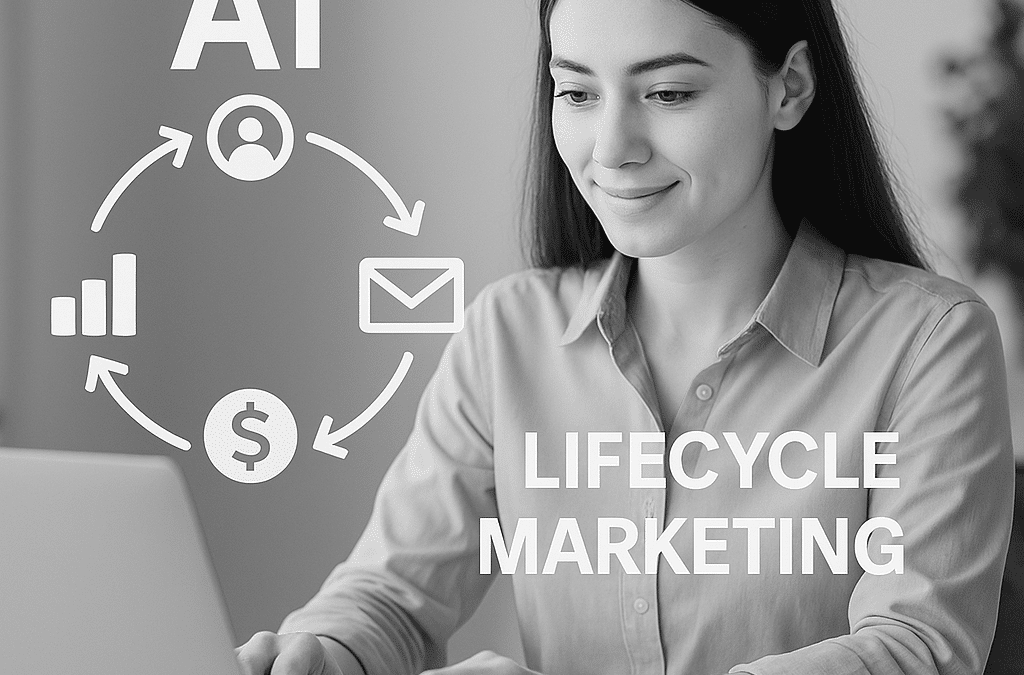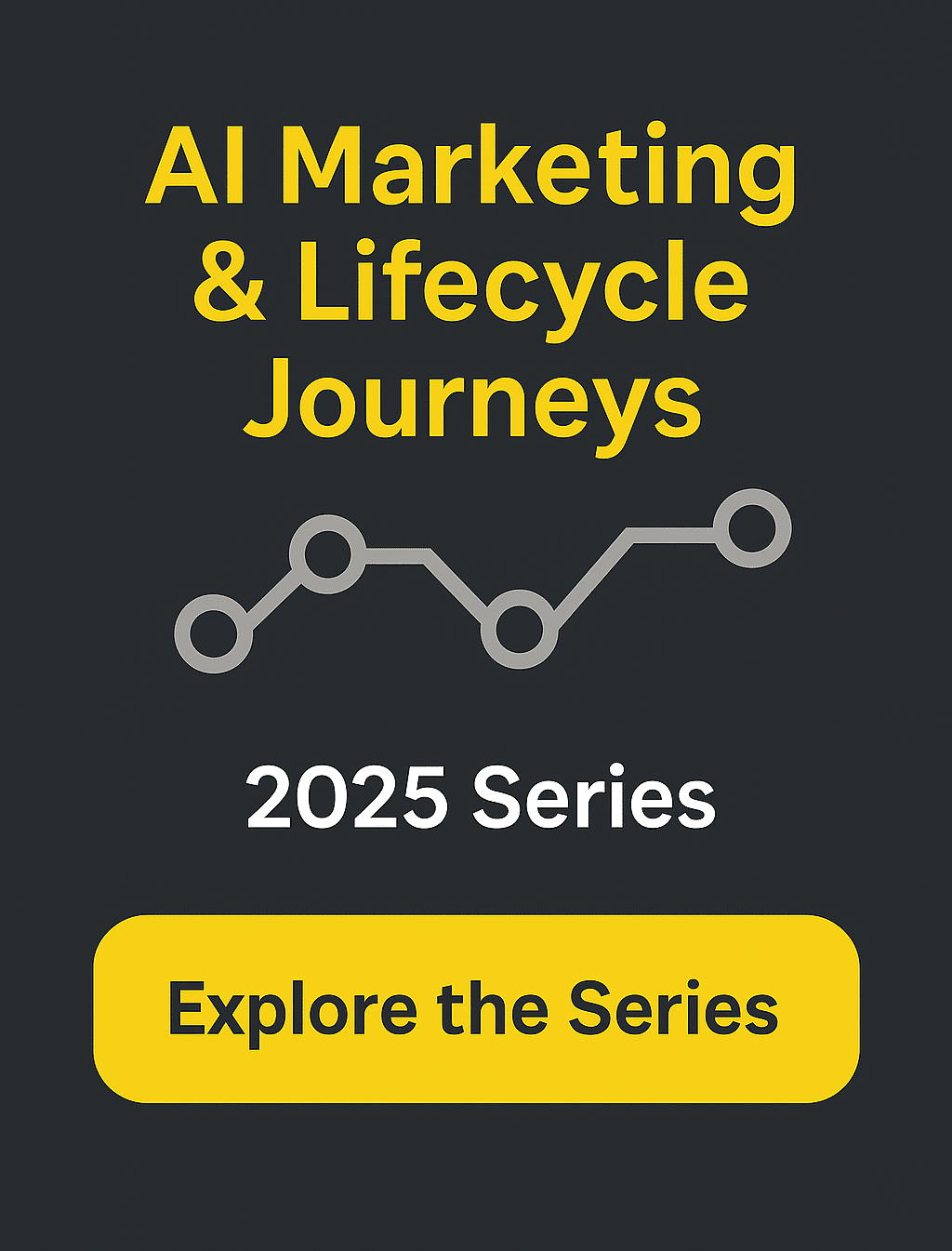This article is Part 1 of a two-part series that builds on our original post, AI-Driven Lifecycle Marketing. I’ve split the original into two shorter, more focused reads to make the content easier to navigate, especially for busy marketing teams exploring AI tools.
This first part covers four key technologies already shaping smarter lifecycle campaigns. Part 2 will focus on what’s next: future-proofing strategies, ethical considerations, and the evolving human-AI dynamic in marketing.
Lifecycle marketing tracks and nurtures customer relationships across every touchpoint. It’s the strategic backbone that connects your marketing efforts across the customer journey. And now, AI-powered lifecycle marketing is transforming how we execute these strategies. From email to content, predictive insights to customer retention, AI helps marketers do more with less, and do it smarter. A recent study by The Conference Board (2024) found that 87% of marketers have used AI tools, and 68% are using them daily. That’s not hype, it’s momentum.
But what does AI actually look like inside a modern lifecycle marketing strategy? In this post, we’ll walk through four powerful AI-driven tools. These are already shaping how brands engage with customers.
1. Predictive Analytics: Your Marketing Crystal Ball
Predictive analytics uses machine learning to identify patterns in customer behavior, both historical and real-time data. It helps you forecast what a user is most likely to do next.
For example, if a user has stopped logging in or hasn’t clicked an email in weeks, predictive models can flag them as at-risk for churn.
It’s like giving your marketing team a sixth sense. They can tell which leads will convert, which customers might leave, and when to take action.
What You Can Do With It
- Prioritize Sales Outreach: Use historical and behavioral data to score leads based on their likelihood to convert.
- Reduce Churn: Identify signs of disengagement, like a drop in logins or email clicks. Then trigger retention campaigns before it’s too late.
- Surface Upsell Opportunities: Flag users who are ready for a higher-tier product or add-on based on usage milestones.
The Gartner CMO Spend Survey (2024) shows that 63% of marketing leaders are investing in AI in the next 24 months. Predictive analytics is one of the top uses for this technology.
Why It Matters
- You’re not guessing, you’re predicting. No more gut feelings! Your campaigns are data-informed.
- Retention becomes proactive, not reactive. You’ll catch problems early, before they impact revenue.
- Lead prioritization gets sharper and more revenue-aligned. You’re nurturing leads and customers at the right moment.
Tool Spotlight
- HubSpot’s Predictive Lead Scoring: Ranks prospects based on deal stage data, activity, and demographics.
- Custify: Monitors SaaS product usage and automates retention outreach.
- Blueshift: Predicts customer intent and orchestrates timely messaging across channels.
2. Hyper-Personalization: Beyond “Hi [First Name]”
Personalization is no longer about using a name merge tag. Instead of grouping users by generic traits like demographics or job titles, you can customize experiences. You would be using behavioral and contextual data to be relevant, at scale. AI makes it possible to tailor your messaging, product recommendations, and email flows for every user in real-time.
A recent Deloitte x AMA CMO Study (2023) found that 33% of marketers use AI. They focus on personalizing customer content in emails, websites, and product recommendations.
What You Can Do With It
- Send Behavior-Based Content: Deliver emails based on the last product seen, the time they check in, or how many times they’ve bought.
- Segment by intent, not demographics: Move away from “female, age 25–34” and instead target “abandoned cart after coupon click.”
- Tailor action dynamically: offer product recommendation or CTAs based on real-time engagement.
Why It Matters
- Hyper-personalization builds long-term trust and engagement. You increase click-through and conversion rates without needing 20 separate segments.
- Customers feel like your brand “gets” them. You deepen trust by showing the customer that you’re paying attention.
- More relevance = more clicks, more conversions, more loyalty. You save time while scaling relevance.
Tool Spotlight
- Dynamic Yield: Offers 1:1 personalization across web, app, and email.
- Klaviyo: Tracks real-time behaviors to personalize product recommendations.
- Adobe Sensei: AI engine that powers smart content targeting across Adobe Experience Cloud.
3. Intelligent Email Automation: Smarter Sequences That Adapt
AI transforms email from a static channel into an intelligent, evolving one. AI allows for automated sequences that change based on behavior, preferences, and timing. This is better than fixed drip campaigns.
The Conference Board’s 2024 marketing tech report shows that 30% of marketers use AI. They mainly want to create and deliver content faster. Email workflows are a key focus.
What You Can Do With It
- Optimize Send Times: AI identifies when a user is most likely to open and interact with your emails—down to the hour.
- Use Dynamic Content Blocks: Email templates adapt on open. They change copy, product images, or CTAs based on the recipient’s latest actions.
- Automate Testing at Scale: AI tests subject lines, headlines, and content continuously. It uses the winning version in real-time.
Why It Matters
- Better performance with less manual tweaking. You run smarter A/B tests without even thinking about them.
- Drip campaigns become more relevant and adaptive. Campaigns evolve in real time without manual rebuilds.
- Marketers save time while increasing engagement. Performance improves quietly, and continuously, in the background.
Tool Spotlight
- Seventh Sense: AI-powered send-time optimization for HubSpot and Marketo.
- Iterable: Supports dynamic content blocks based on custom events and user behavior.
- Mailchimp’s Creative Assistant: Uses AI to personalize and adapt visuals and messaging.
4. Conversational AI: Chatbots That Actually Help
Today’s AI-powered chatbots do more than just field FAQs. They’re trained to hold meaningful, contextual conversations. They qualify leads, recommend products, and hand off to your sales or support teams.
Deloitte (2023) found that 26% of marketers are already using AI to improve customer service, and chatbots are at the core of that shift.
What You Can Do With It
- Pre-qualify leads 24/7 by asking smart, branching questions. Ask users discovery questions and route qualified leads to reps instantly.
- Guide users through product discovery with dynamic chat flows based on prior page views or search terms. Offer personalized product recommendations or guide users through your funnel inside the chat.
- Capture zero-party data (the info users share directly) to boost personalization while respecting privacy. Store chat data and activity as part of your full customer profile.
Why It Matters
- You increase your lead conversion without increasing headcount. Chat becomes a conversion tool—not just a support function.
- Customers get instant answers, even outside business hours.
- You build context-rich profiles that feed better targeting later.
Tool Spotlight
- Drift: Conversational marketing platform with lead qualification and scheduling.
- Intercom: AI bots that engage, escalate, and hand off within chat flows.
- Tidio: Offers AI and live chat for eComm and lead gen, with Shopify and Zapier integrations.
Getting Started: Your AI Implementation Roadmap
AI-powered lifecycle marketing isn’t a magic button. It’s a set of tools that, when used thoughtfully, can enhance every stage of the customer journey. Here’s how to begin:
- Audit Your Current Lifecycle Gaps: Identify where your customer journey has friction or drop-off points. Look for areas where you lack data insights or where manual processes slow you down.
- Choose One High-Impact Pilot Area: Pick a stage in your lifecycle marketing. Set clear KPIs, like boosting email engagement during onboarding or cutting churn with better predictions. Focus yields faster results.
- Start With Ready-Made Solutions: Many platforms mentioned in this article offer pre-built AI capabilities that integrate with your existing stack. Begin with these before custom development.
- Set Clear Success Metrics: Define what improvement looks like before implementation. Is it 15% better email engagement? 20% reduction in churn? Baseline your current performance.
- Create a 90-Day Test Plan: Implement your chosen AI tool for a full quarter. Measure results against your established KPIs and make adjustments as you learn.
When AI is used to inform your content, timing, and segmentation decisions, the result isn’t just automation. It’s smarter marketing with better outcomes. Include your team in the journey. Success with AI needs both tech adoption and teamwork.
Works Cited
-
- Delegge, P. (2024). How AI is transforming marketing. MarketingHire. https://www.marketinghire.com/blog/how-ai-is-transforming-marketing
- Deloitte. (2025). Now decides next: Generating a new future. https://www2.deloitte.com/us/en/pages/consulting/articles/state-of-generative-ai-in-enterprise.html
- The Conference Board. (2024). AI marketing and communications survey: CMO and CCO meter.https://www.conference-board.org/research/CMO-CCO-Meter/AI-Marketing-Communications-survey
- Gartner. (2003). Gartner Survey Finds 63% of Marketing Leaders Plan to Invest in Generative AI in the Next 24 Months. https://www.gartner.com/en/newsroom/press-releases/2023-08-23-gartner-survey-finds-63-percent-of-marketing-leaders-plan-to-invest-in-generative-ai-in-the-next-24-months
- Hughes, D. (n.d.). Best examples of AI in marketing. Digital Marketing Institute. https://digitalmarketinginstitute.com/blog/some-inspiring-uses-of-ai-in-digital-marketing




